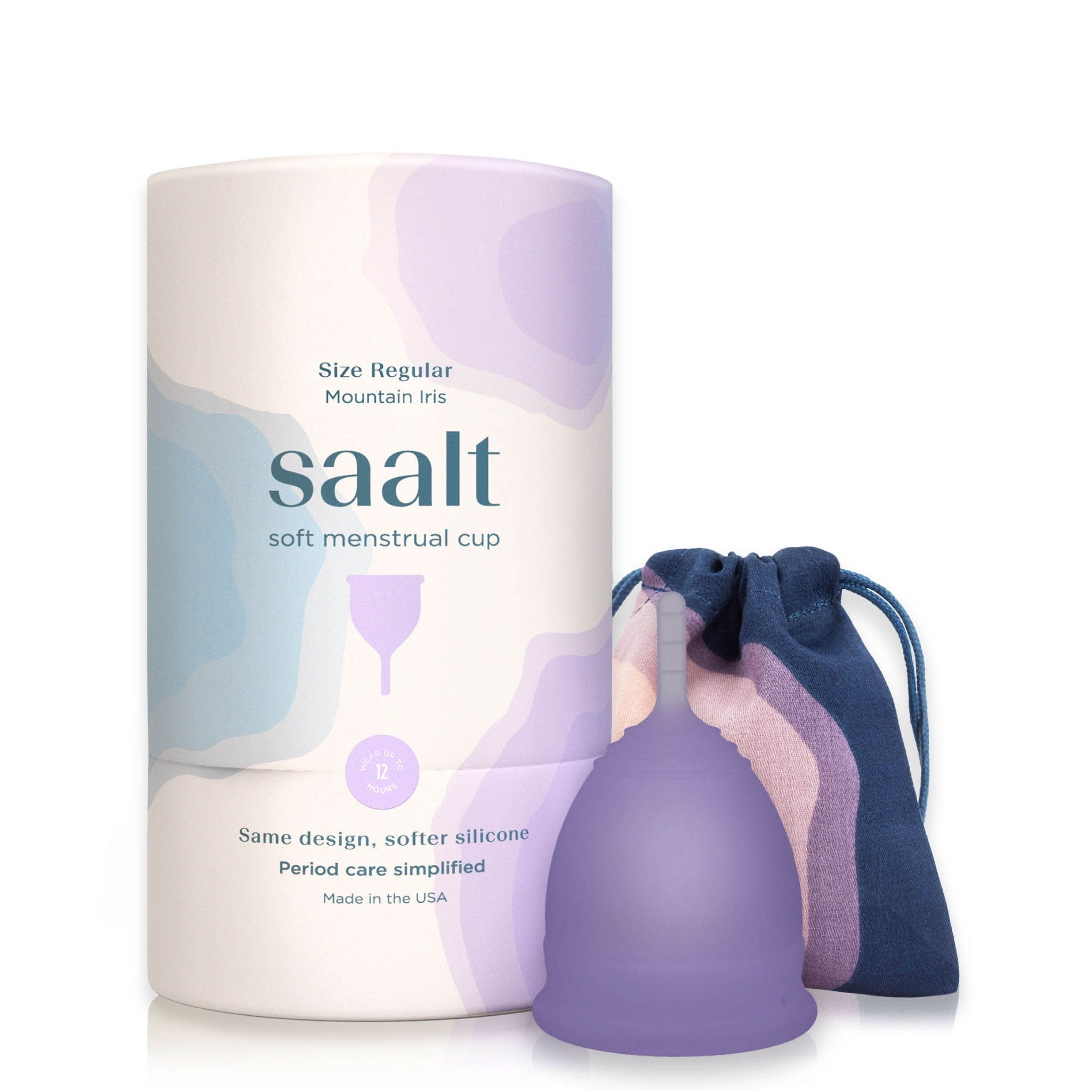Do you experience heavy or uncomfortable cramping, headaches or migraines, bloating and digestive issues, crippling fatigue, intense moodiness or nausea before or during your period?
If so, I see you, I hear you, and you're not alone, with the American College of Obstetricians and Gynecologists (ACOG) estimating up to 90% of adolescent girls and women in their reproductive years experiencing some sort of period pain (also known as Dysmenorrhea).
And while these symptoms are way too common, they are not normal, rather a sign of an underlying condition or hormone imbalance. While this might be disheartening to hear, the good news is you can reduce period pain and heal your menstrual cycle through simple and accessible lifestyle changes. Read below for the tips that have helped hundreds of people who menstruate (as well as myself, who used to suffer from cramping so intense I'd be bedridden) on our journey towards a better period.

1. Non-Toxic Period Products + Saalt Menstrual Cup
Conventional period products (tampons, pads, etc.) are often expensive and contain known toxins, including aluminum, alcohol and fragrance additives. But perhaps worst of all, they're bleached in the production process, leaving behind traces of dioxins in our bodies that can lead to cramping, painful periods and hormone imbalances like endometriosis.
Using a menstrual cup, which is made with a non-toxic, ultra-soft silicone formula, eliminates the need for toxic period products and saves you money (1 cup can last up to 10 years) while cutting down on environmental waste in the process. Shop: best menstrual cup or best menstrual disc.
I also like the Saalt Soft Cup because it's super flexible and discreet. I forget about it once it's in there and only have to switch it out every 12 hours (following proper cleaning instructions and care of course). It's gently designed for people who might have had discomfort with firmer cups or any bladder/vaginal sensitivity, but still super effective.
2. Allow Time To Rest
Your period is triggered when your progesterone levels drop, causing the lining of your uterus to break down and shed. During this phase your hormones and energy are at the lowest they will be during your cycle, while your body clears out what's no longer needed and prepares for new growth.
This "inner winter phase" requires rest and replenishment, and by trying to push through and force intense workouts or peak productivity you risk depleting your bodies of nutrients and energy needed for your upcoming cycle, leading to systemic inflammation, burnout, and increasing your risk for continual PMS, cramping, bloat and painful periods.
While it can be tough to do in this culture of go-go-go, scheduling some downtime and allowing yourself to sleep in, nap, or simply be without guilt will work to restore energy, reduce period pain, and have a healthy cycle.
3. Eat Warming + Remineralizing Foods Often
Because your hormones are at their lowest levels during your period, it's crucial to replenish and remineralize with foods that work to keep your energy and mood stable while your brain adjusts to the downshift in your cycle.
Foods loaded with iron and zinc, such as beef, bison, lamb, seafood and sea veggies, beans, nuts, seeds, and leafy green vegetables are deeply restorative to your blood and kidneys, working to remineralize your body and replenishing nutrients lost due to bloodshed.
According to Traditional Chinese Medicine, this is also the coldest part of the cycle (i.e. inner winter phase), so it's helpful to incorporate warming foods like bone broth, soups, casseroles, and stews.
4. Incorporate Herbs + Supplements
Adding herbs and supplements to your routine can be incredibly effective at reducing cramping and painful period symptoms by working to balance hormones and your menstrual cycle.
Below are a few of my faves:
- Red Raspberry Leaf - Drink as a tea or infusion during your period to help cramping and replenish iron in the body
- Nettle - Drink as a tea or infusion to support blood loss and remineralize the body
- Cramp bark - Helps relieve cramping associated with menses. Take as a tincture or tea daily
- Turmeric & Ginger- Highly anti-inflammatory spices that work to support the digestive system and help with menstrual cramps. You can add to food or take as a capsule daily
- Chaga Mushroom - This adaptogen is one of my favorites due to its earthy taste and ability to support immunity and regulate energy. Drink or add to recipes in powdered form
- Magnesium - Try citrate to help with elimination and glycinate to support sleep and diminish menstrual cramps. You can also rub magnesium oil on your belly to help ease cramps
- B-Vitamins - Crucial for optimal energy, try taking an activated B complex
5. Epsom Salt Baths
Not only can a hot bath be incredibly relaxing (as a mom of a toddler it also seems like a total luxury), but adding Epsom salt works to relieve cramping and muscle tension while promoting optimal sleep.
This is thanks to the high magnesium content in Epsom salt, which works to relax uterine muscles contracting and offer cramping and pain relief. If a hot bath isn't in the cards for you, you can also take a hot shower and use an Epsom salt scrub.
6. Journal + Self-Reflection
Both spheres of your brain are communicating powerfully during your menstrual phase, enabling you to tap into your gut and intuition. While this practice doesn't directly affect physical symptoms, it does help you reflect on current habits and where to make changes moving forward in order to ensure a healthier monthly cycle.
7. Gentle Movement
While it may seem counterintuitive, it's important to avoid high-intensity workouts during your period, which puts additional strain on your adrenals, causing you to pump out more stress hormone cortisol in order to sustain enough energy during your workouts.
Over time this can lead to excess estrogen (which makes it even more difficult to lose weight) and adrenal dysfunction that compounds period pain and other hormonal imbalances.
Cycle-syncing your workouts by doing more high intensity in the first half of your cycle (follicular + ovulatory) and gentle, low-impact activities like walking, stretching, and restorative yoga in the second half (luteal + menstrual) supports your hormonal fluctuations, puts less stress on your adrenals, boosts your metabolism + energizes your body.
8. Incorporate Heat + Warmth
During your period, your body temperature drops, making it an important phase to create warmth within your body. As mentioned above, opting for warm meals (soups, bone broths, etc.) is a great way to support your digestion and reduce physical symptoms during your period, but there are plenty of other ways to use warmth to heal. I recommend clients apply heat (like a hot water bottle) directly to the uterine area to ease cramps, do an infrared sauna (if possible) or simply lay in the sun, which also has the added benefit of vitamin D synthesis for overall hormone balance.
9. Hydrate With Water + Herbal Teas
While hydration is essential for optimal health and hormone balance, it's especially critical during your period to help with bloating and cramping. Along with drinking a minimum of half of your body weight in fluid ounces, I recommend adding warming herbal teas and infusions like raspberry and nettle leaf (works to replenish lost nutrients and tone the nutrients) as well as ginger (lower inflammation and optimizes digestion).
Bottom Line
While uncomfortable symptoms and period pain are common, they are not normal. Your body is working extra hard to do amazing things during your menstrual phase, and the more we allow ourselves to rest, replenish, and recharge, the better our periods will be - allowing our hormones, health, and happiness to thrive.
About the Author: Lauren Chambers
Lauren Chambers is the Nutrition + Hormone Health Coach and Feel Good Food Blogger of sofreshnsogreen.com. She's on a mission to help you balance your hormones, boost your energy, and improve your mood through food, so you can look and feel your best.





